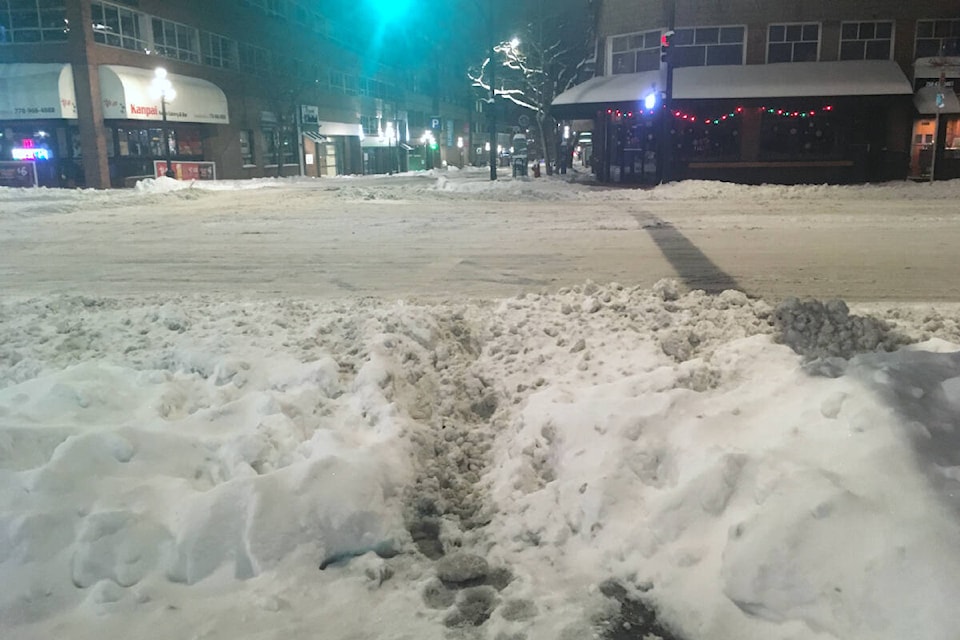In a Utopian society, we would all look out for each other and that may be the only real solution to the challenges people with disabilities face when snow and ice hit the region.
But the threat of flurries appearing off and on in the forecast in these final weeks of winter may have some planning ahead more than others.
It’s not an uncommon practice for those who face added challenges when the generally mild coastal winters get a little wild, says Wendy Cox, executive director with the Victoria Disability Resource Centre.
‚ÄúMost of us try to prepare beforehand. We keep an eye on the weather and put things into place, like moving appointments, stocking up on food and medication, putting a support system into place,‚ÄĚ Cox said.
READ ALSO:
Most municipalities have sidewalk clearing as a standard streets bylaw, requiring residents to clear the public paths adjacent to their homes in a timely manner. For example, in Saanich ‚Äď the largest municipality in Greater Victoria ‚Äď property owners are to keep adjacent sidewalks clear of snow by 10 a.m. the following morning after a snowfall. There are avenues to complain about non-compliance and those are dealt with as resources allow.
Other public spaces fall to Saanich Parks to clear, and are dealt with on a priority sequence, similar to road clearing.
But not everyone can do the clearing, and those who do, don’t always maintain a standard that allows anyone but the most nimble to traverse the streets.
READ ALSO:
‚ÄúMost sidewalks, if shovelled at all, do not provide a wide enough path for more than someone who is ambulatory to navigate,‚ÄĚ Cox said.
When parking lots are cleared, the snow is often piled into the accessible parking spaces.
‚ÄúNot only that, but it then takes several weeks for the snow to melt before the accessible space is actually accessible again. Even when the snow is plowed to the back of the parking lot, there often is not a cleared path from the accessible parking to the entrance.‚ÄĚ
The impact can be broad ‚Äď people living with disabilities are unable to get to work, shop for food, pick up medication, walk their dog, get to medical appointments or get their kids to school.
READ ALSO:
It’s not just those who use mobility aids who are impacted by snow.
‚ÄúPeople who are blind or partially sighted can‚Äôt access tactile indicators, such as the truncated domes and scribes that show where the curb cut is that warns that they are about to enter a roadway,‚ÄĚ Cox said. ‚ÄúThe blanket of white snow also takes away most contrasting indicators. For example, where the grey sidewalk and green grass meet.‚ÄĚ
Even without the snow, the recent dips in temperature can impact those who are deaf or hard of hearing. Those who rely on sign language or lip reading to communicate are limited with the use of gloves and scarves.
Older adults are also at a risk of slipping and falling, Cox noted. More than one-third of older adults hospitalized due to a fall, and released are not able to return to their homes and wind up in long-term care homes ‚Äď separated from their partners, families and neighbours.
Solutions are, of course, a hot topic for the Disability Resource Centre, with discussions on penalties for those who do not properly clear their sidewalks but not everyone is able to physically shovel snow, Cox acknowledged. If municipalities took over responsibility for clearing sidewalks, it would likely be costly to the taxpayers.
A long-term solution could be a service where people can register to receive help.
‚ÄúThey can call to get groceries or medication delivered,‚ÄĚ Cox said, leading back to the original point.
Most folks keep a keen eye on the weather, and if they have supports available, plan ahead as best they can.



